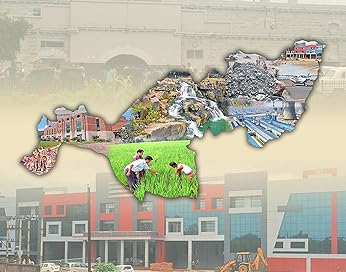Jajpur District was formed by ‘Jajati Keshari’, the Somavanshi King in early 10th Century. The District takes its name from its head quarter town, Jajpur. The history of the Jajpur District from time immemorial is synonymous with the Biraja and Biraja Khetra. The Jajpur District came into being on 1st April 1993. Prior to that it was part of Cuttack District which divided into four Districts. The District is bounded by Keonjhar and Bhadrak Districts on its North, Cuttack on its South, Dhenkanal District on its East and Kendrapada District on its West.
The Jajpur District located in between 20 degree 30’ to 21 degree 10’ North Latitude and 85 degree 40’ to 86 degree 44’ East Longitude. The District covering an area of 2887.69 sq km is moderately populated having total population of 18,26,275 as per 2011 census.
As per the administration is concerned the Jajpur District has got one sub division namely Jajpur. There are 10 Tahsils, 10 Blocks, 311 G.Ps, 1781 Villages and 18 Police stations functioning in the District.
The climate of Jajpur District is normal as per Indian standards. All the seasons arrive in the District at their usual time. The District’s average height from the sea level is 331 mts and its average rain fall is 1014.5 mm. The average maximum and minimum temperatures are 38 degree C and 12 degree C respectively. Overall, the climate of the District is neither hotter nor cooler.
Economy of the District is agrarian in nature. Agriculture and mining play dominant role in the economy of the District . In recent years, Jajpur District has taken major strides in industrial development. The most industrially developed area of the district, Kalinga Nagar, is situated in Danagadi Block, where currently 4 small steel plants are operating and 9 more are on their way to start production. Big plants like Mesco, Neelachal Ispat, Maithan, Tata Steels, Brahmani Rever Pellets Limited and Jindal Stainless Limited have set up their operations here. Daitari mines are famous for the mining extracts, which the state exports to the outside world, thereby gaining substantial revenue.
Jajpur District is having the third best conditions for sustainable development in agriculture followed by Bargarh and Jagatsinghpur Districts. Rice is traditionally grown in two well defined seasons, namely kharif and dalua. Of these two, kharif (rainy) is the most important rice season. The kharif rice is the main crop, covering over 85 percent of the total rice area, and depends entirely on the southwest monsoon. It is sown in June and harvested in October–December, depending upon the duration of the cultivation and topography of the field. The dalua (summer) crop coincides with the dry season and depends entirely on irrigation. The source of irrigation water is tank. The dalua season stretches from December–January to April–May. Farmers grow only high–yielding varieties during this season.
The literacy rate of the Jajpur District is 80.44 percent. The District is proud of its many educational institutes, many of which have produced eminent scholars over the years. B.B. High School, Dasarathpur High School, N.C.College, V.N College, N.C College, Biraja Women’s College, Biraja Law College, B.S.College, Sukinda College, and A.P.College are some of the major educational institutes thriving on the principles of imparting quality education.
Public Representatives
List of Members of Parliament of the District
| Sl. No. | Constituency name | Name of MP | Photo |
| 1 | Jajpur | Sarmistha Sethi |  |
List of Members of Legislative Assembly of the District
| Sl. No. | Constituency Name | Name of MLA | Photo |
| 1 | 48-Binjharpur(SC) | Pramila Mallick |  |
| 2 | 49-Bari | Sunanda Das |  |
| 3 | 50-Barchana | Amar Prasad Satpathy |  |
| 4 | 51-Dharmasala | Pranab Kumar Balabantaray | |
| 5 | 52-Jajpur | Pranab Prakash Das |  |
| 6 | 53-Korei | Ashok Kumar Bal |  |
| 7 | 54-Sukinda | Pritiranjan Gharai |  |








